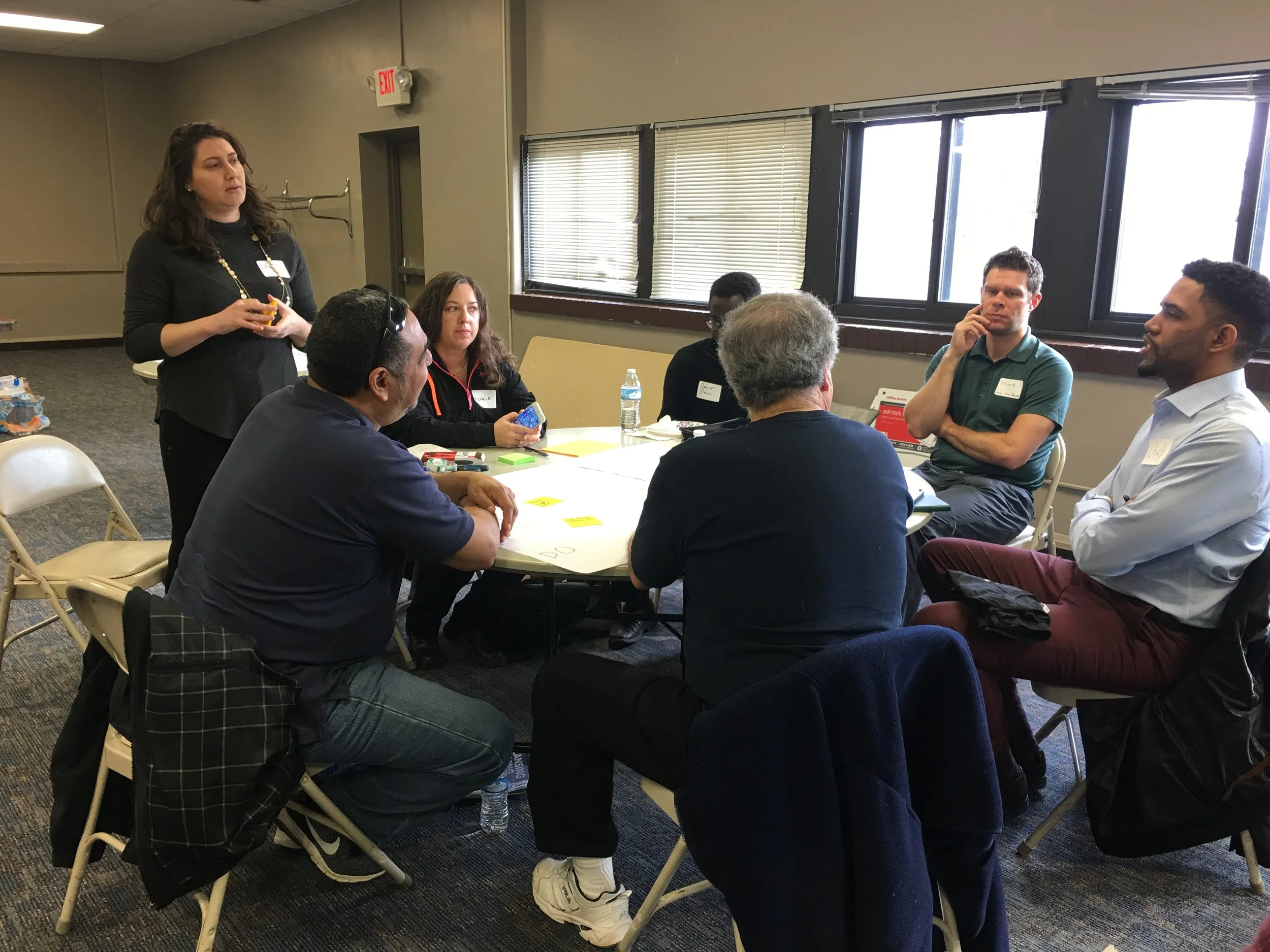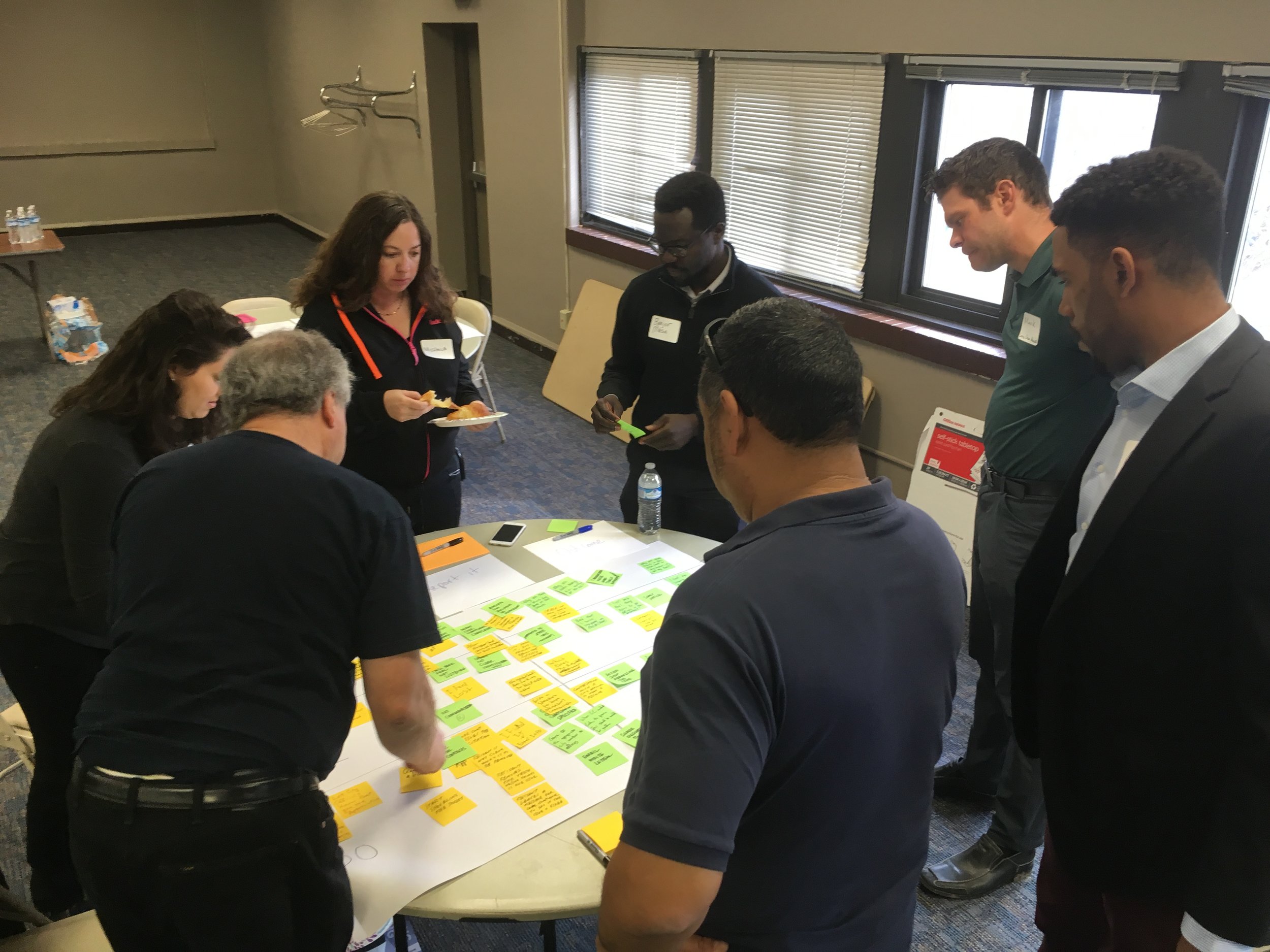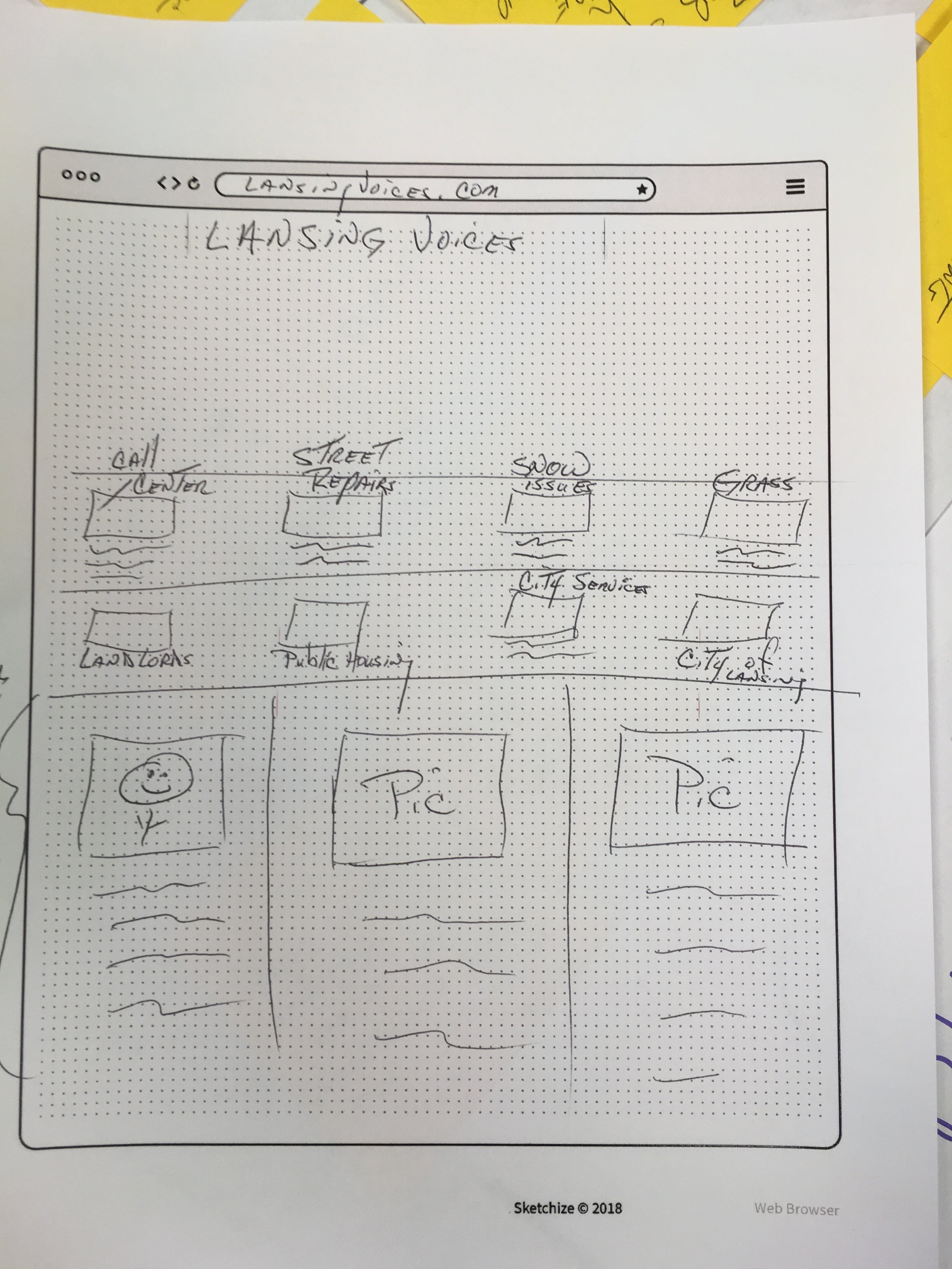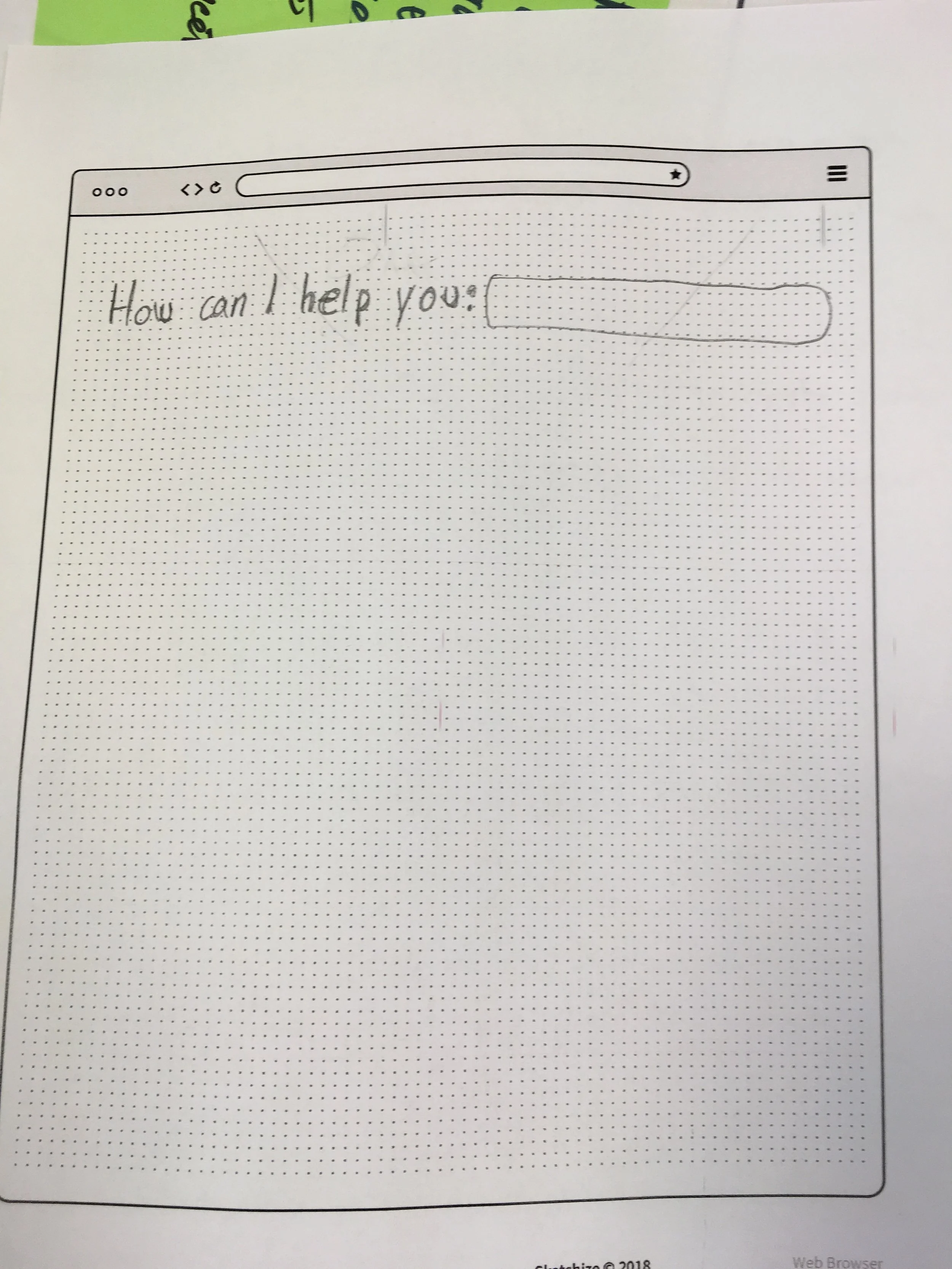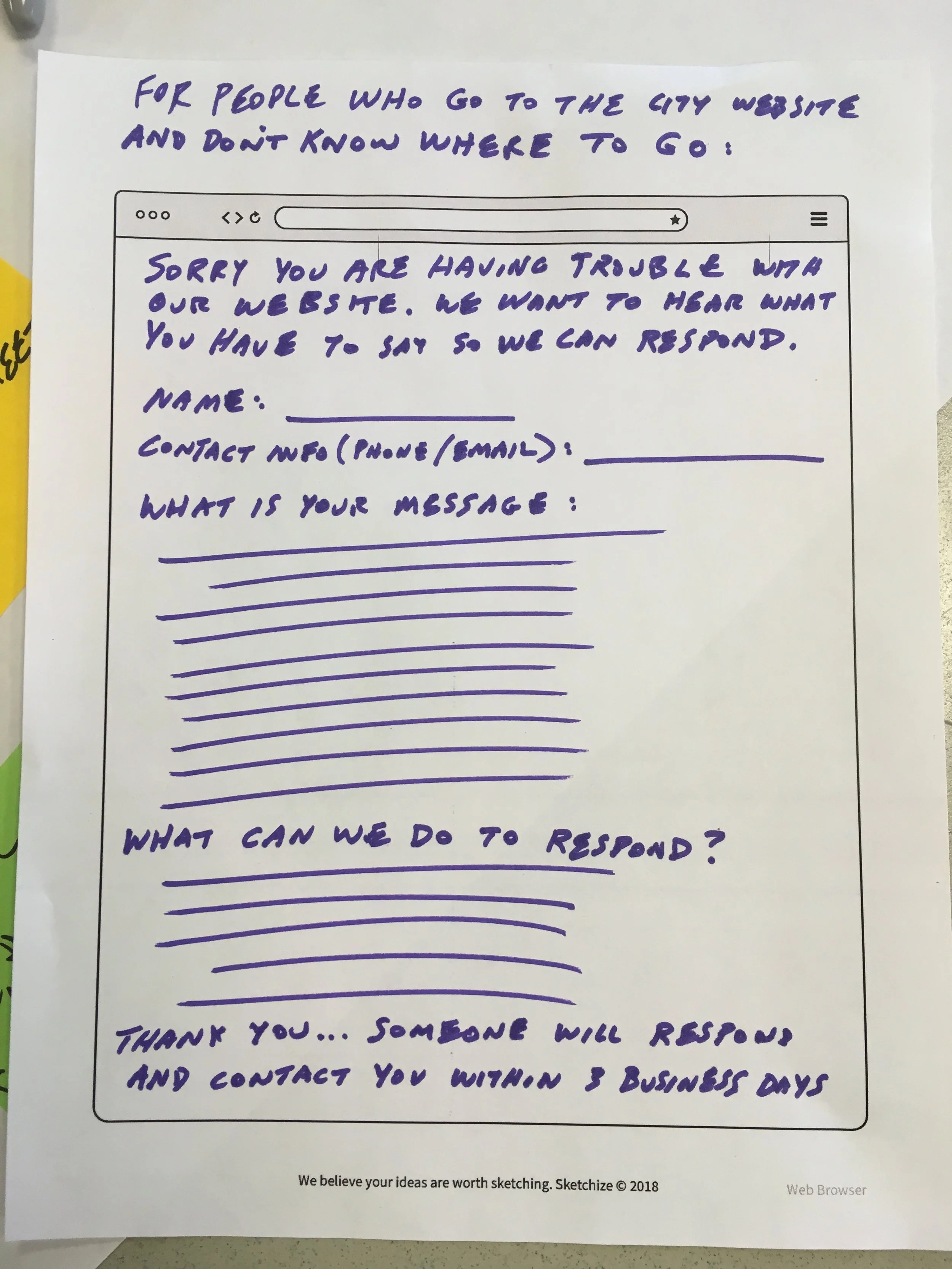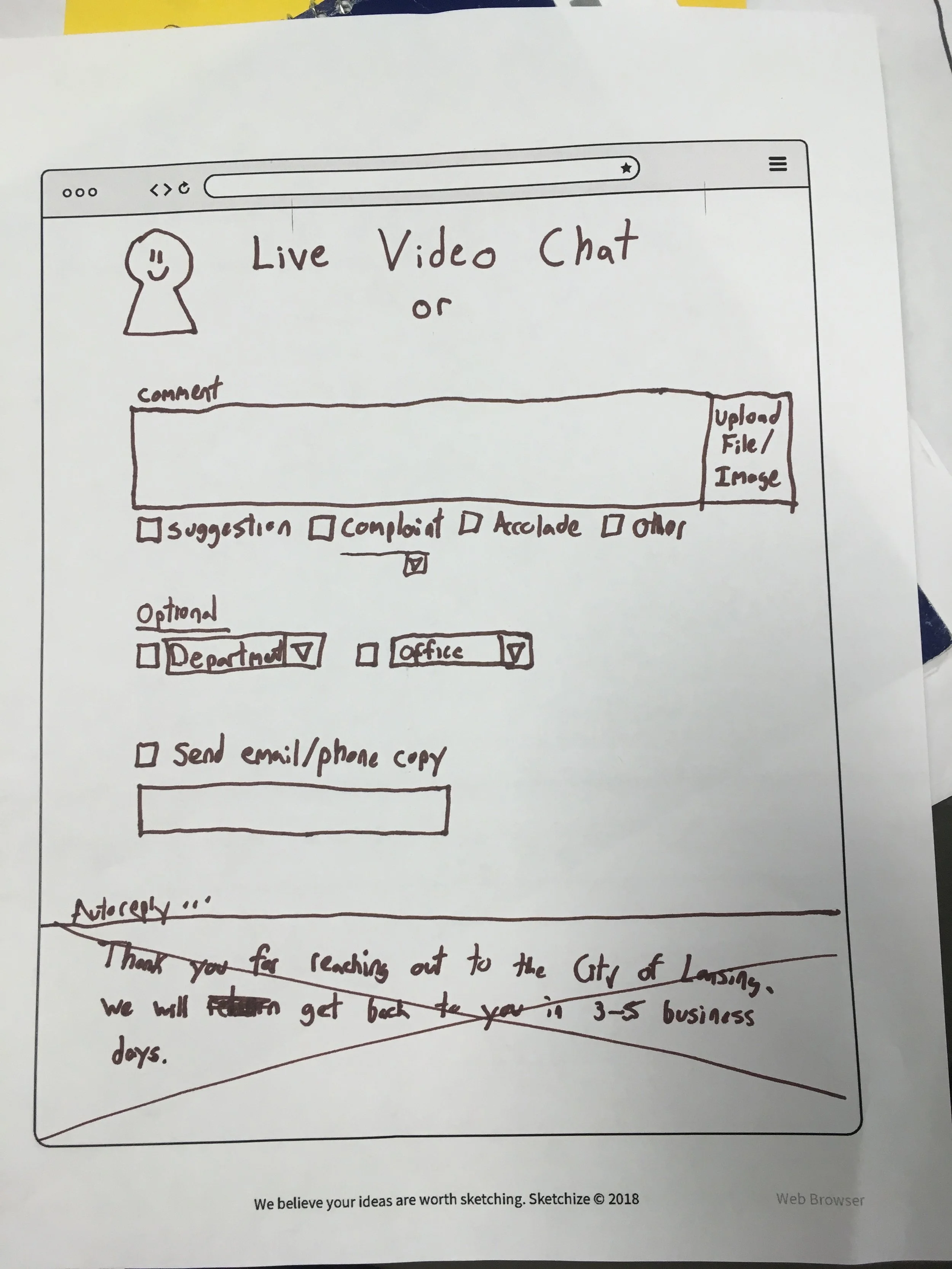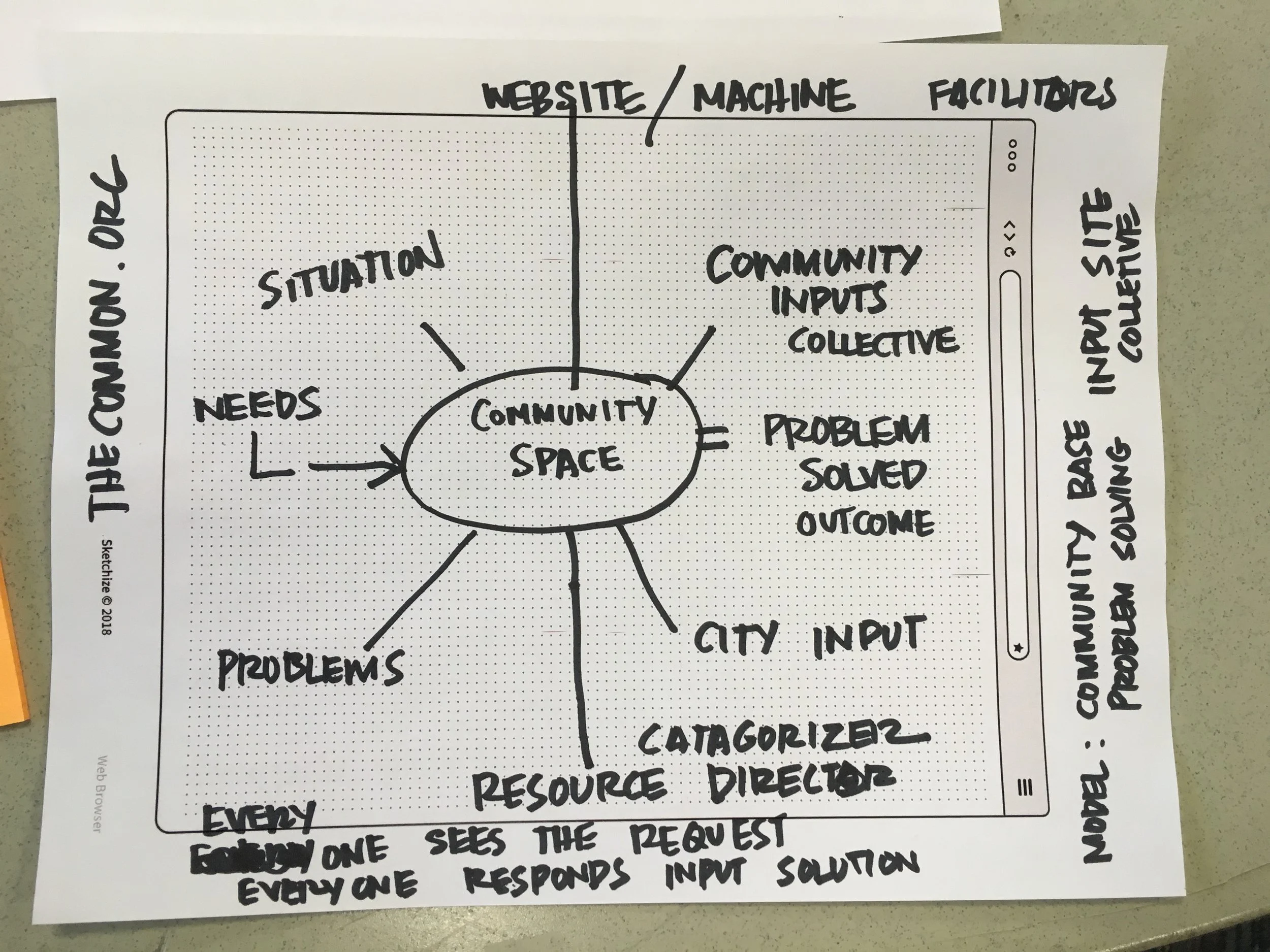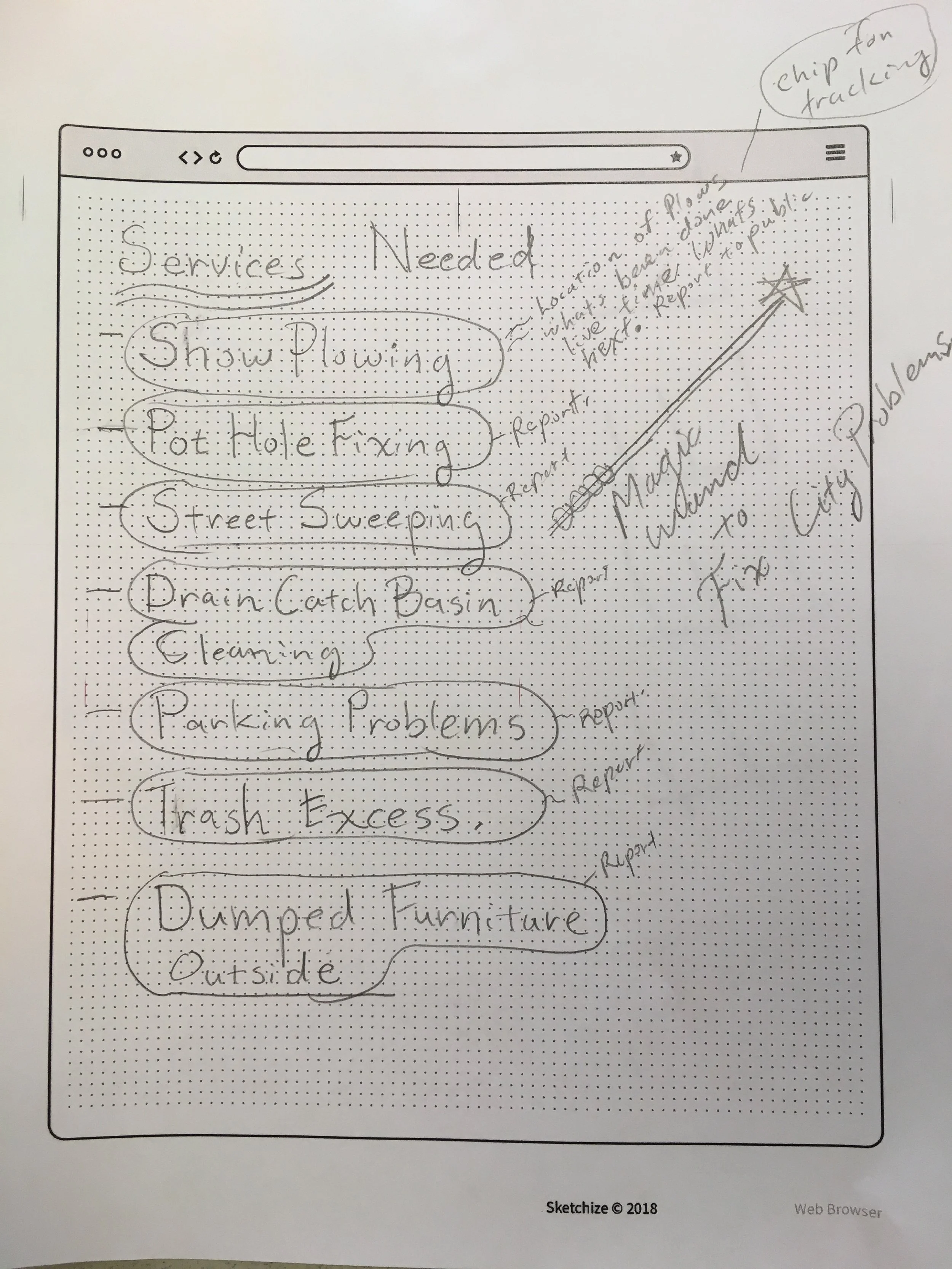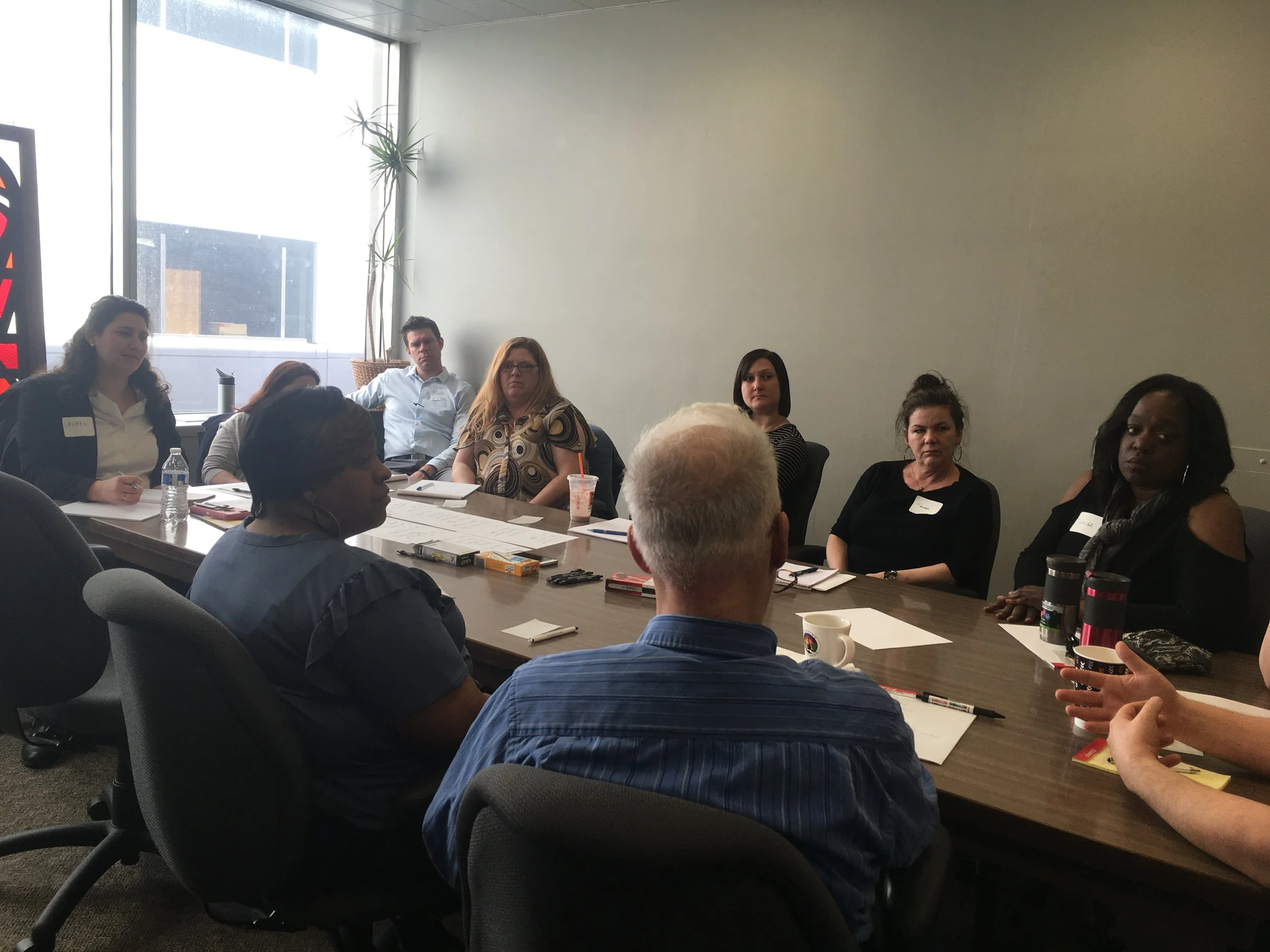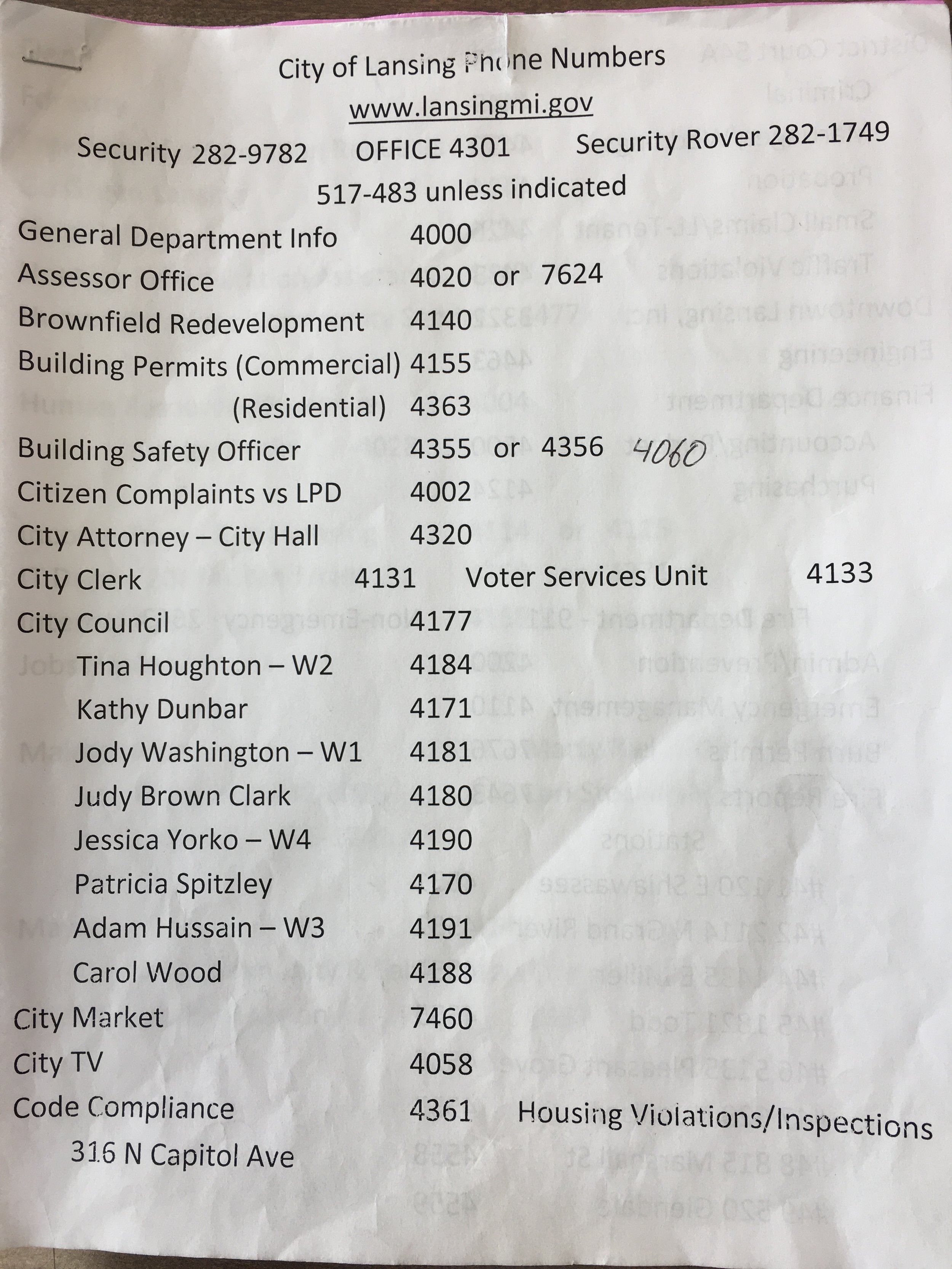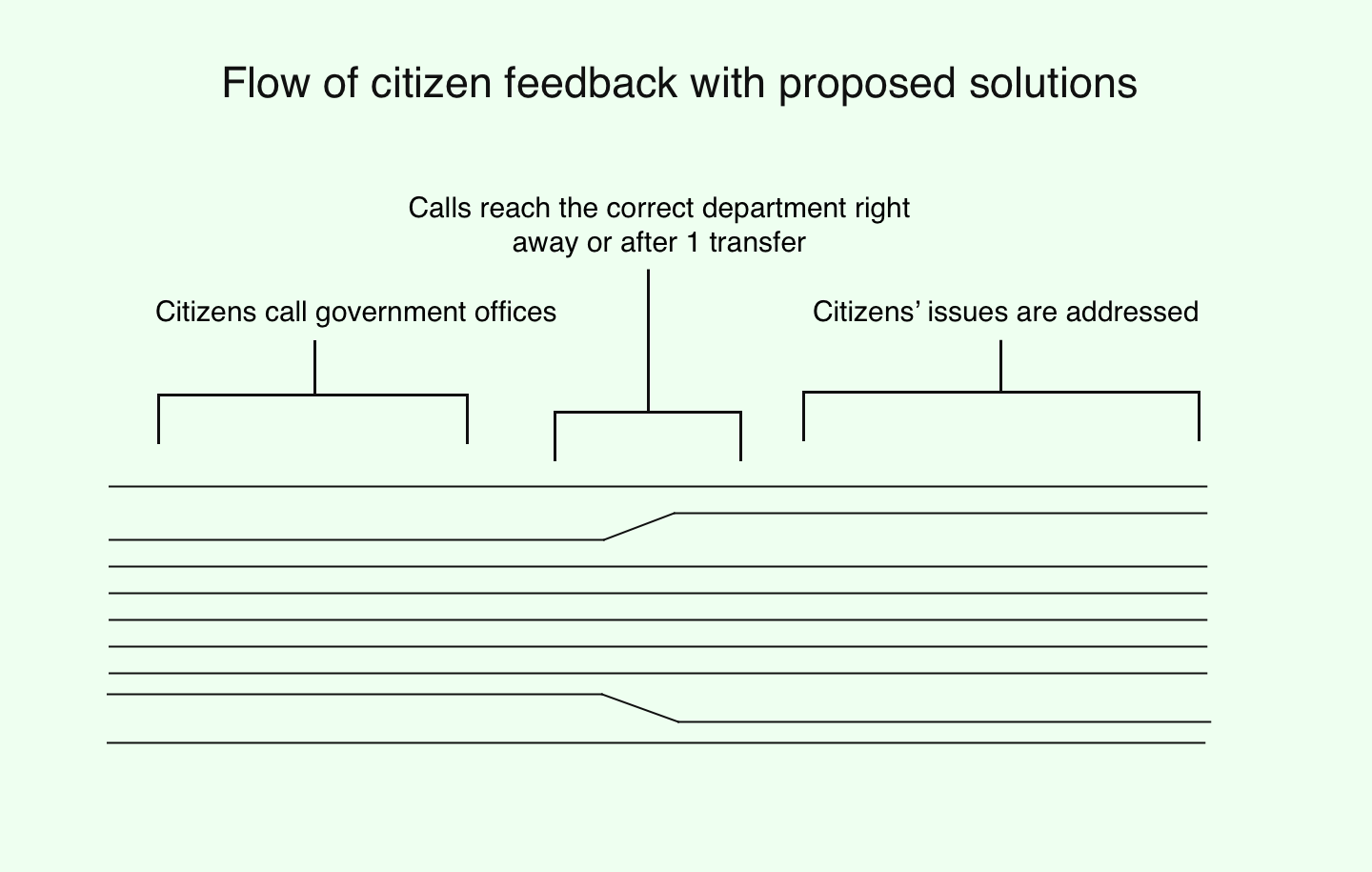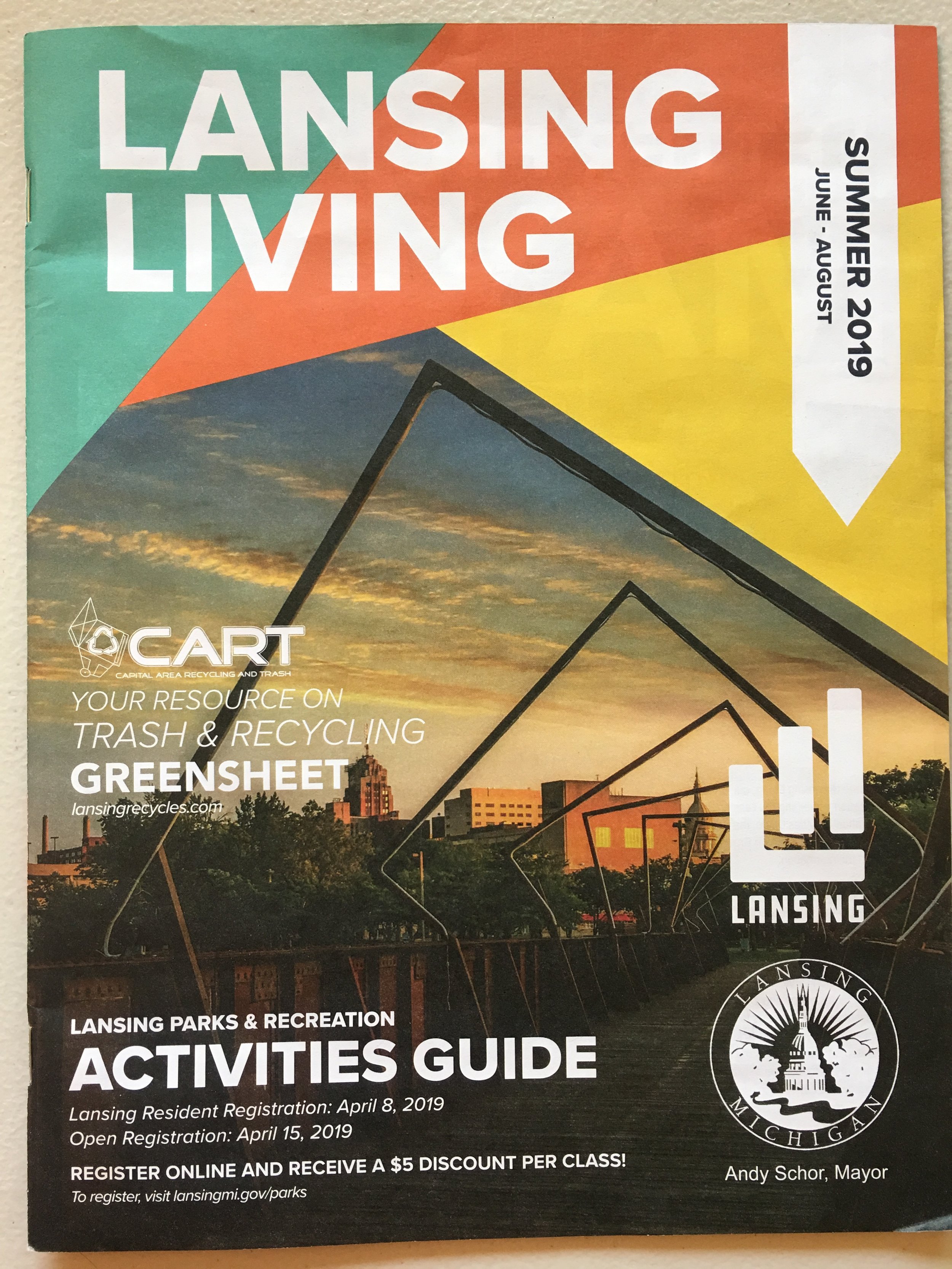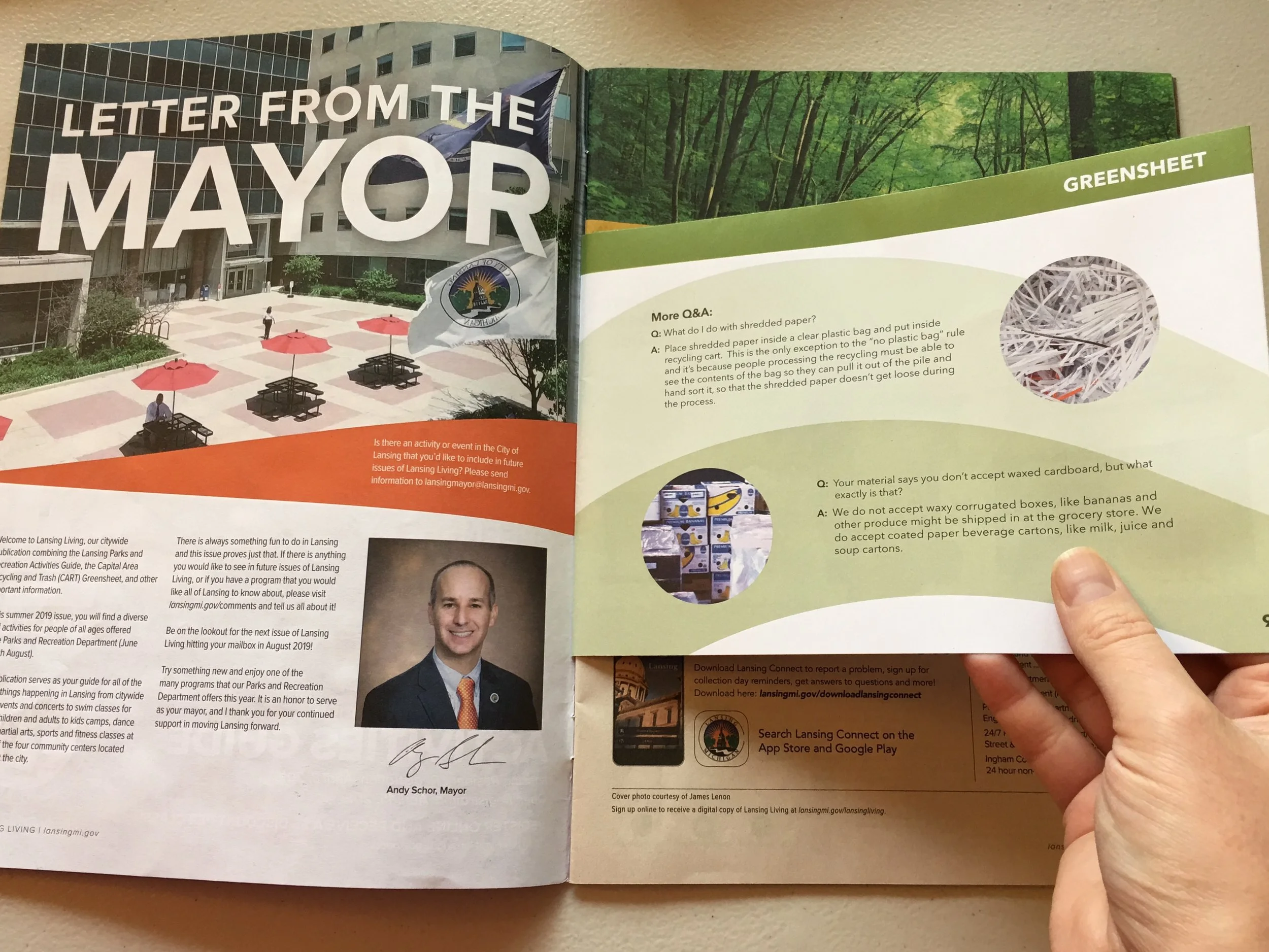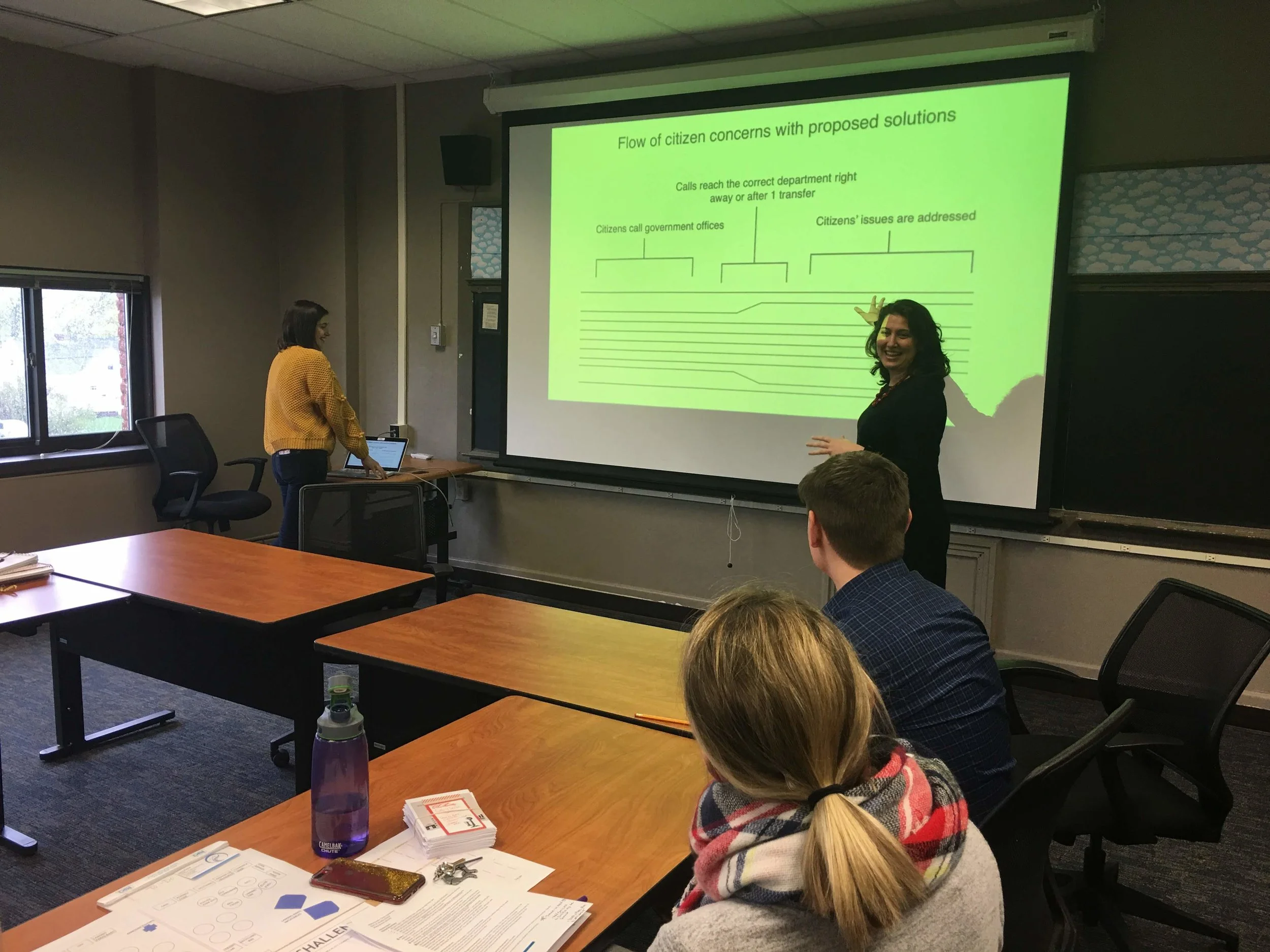Routing Citizen Feedback in the City of Lansing
tl;dr: I led a participatory design activity with Lansing residents and city employees and a focus group with city employees in order to understand the flow of citizen feedback through the City of Lansing. After analyzing the data from citizens and city employees, my teammates and I provided recommendations about how to improve the citizen feedback process to the Department of Neighborhoods + Citizen Engagement of the City of Lansing.
Role: UX Researcher
The Initial Challenge
The City of Lansing is considering opportunities and tools to improve the collection and coordination of citizen input. What do they need to understand about the people reaching out to them?
Immediately, the Challenge Changes
Initial Client meeting
Initially, the client wanted to improve the collection of citizen feedback. But the initial client meeting revealed that there was a problem routing citizen feedback within the government.
Calls frequently bounced between department
Citizens called multiple times until they got an advocate
Citizens called with “emergencies” to get extra attention
Lack of Tracking
Citizen concerns get lost in the shuffle
If the city suddenly got more effective at collecting and coordinating citizens’ feedback, then it would have even more trouble routing citizens’ concerns.
Pivot in research direction
After carefully considering our client’s words in our initial client meeting, we pivoted our focus from improving the collection and coordination of citizen input to understanding and improving the flow of citizen feedback through the City of Lansing.
Research Question:
What is the journey of information through the City of Lansing’s comment and complaint process?
What are the Citizens’ pain points in the current process?
What are the City workers’ paint points in the current process?
Secondary Research & Comparative Analysis
Our group conducted secondary research to get a better idea of how the city functions. We conducted a comparative analysis to find out how other cities handle these types of information organization and information routing.
Findings
Lansing has a strong mayor style of government. That means that the Mayor has an inordinately large amount of power as compared to other types of city governments - like a city counsel. The Mayor has the final say on many of the decisions in the city. Based on this information, we predict that the mayor’s office will get a deluge of citizen input as compared to other departments.
The comparative analysis showed that the gold standard for routing citizen comments and complaints is a 311 call center. Call center employees are able to answer most, if not all, citizen concerns. Any questions employees can’t answer will be routed to the correct government department.
Impact on next steps
The strong mayor government, and the possible information deluge to that office made us want to have a deeper understanding or how the government routes information.
The call center made us want to research the current system(s) that Lansing was using to route comments and complaints.
Participatory Design Empowers Citizens
Our first research method was a participatory design (PD) activity. One of the principles of PD is that the user of the system is considered the expert, rather than an outsider. We chose a PD as our first research method because we wanted to empower citizens as experts on their experience with the City of Lansing’s comment and complaint process. To do this, citizens and employees created a journey map of their experiences. We also wanted them to embrace that authority when they recommended ideal solutions in the magic screen activity. The PD activity lasted 2 hours.
Journey Map and with citizens and city employees
Magic Screen Activity
Vitriol Surprise!
We were not expecting Lansing residents to speak about the government with vitriol, and then aim that vitriol directly at the two employees who came to the PD. Moreover, the citizens weren’t talking through their experience from beginning to end. They were focusing in on a single heightened negative emotion in their experience and then discussed that on a loop.
As a group we handled this in two ways:
I talked to each of the tables and reminded them that the city employees who were there wanted to listen to their concerns and help address them. These individual employees aren’t the reason for their problems, but in fact, part of the solution.
I called a huddle with my teammates mid-PD and suggested that we give the “think, feel, do” activity more structure, creating a journey map. I suggested adding “Notice Something,” “Report It,” and “Resolution.” My teammate countered that some citizens’ issues didn’t get a resolution, how about “Outcome?” He made an excellent point, and that’s what we did.
Both of these things worked well and got the PD back on track. By the end of the focus group, my team was able to get high-quality qualitative data about the citizens’ comment and complaint experience from beginning to end and the city workers were able to steer citizens toward funding for neighborhood beautification.
Findings: Confusion = Vitriol
Finding 1: Citizens, “Who do I contact?” Citizens aren’t sure who to contact or how to contact them, when they have a comment or complaint.
Calls bounced around
Website is horrible
Lansing App only good for a handful of things
Findings 2: Citizens feel like they’re not being heard
Citizens don’t know where their complaint is in the process of getting resolved.
Citizens aren’t told when their comment or complaint has been addressed.
Despite complaints, the city isn’t doing any better at snow plowing, leaf collection, trash collection, etc.
Citizens expect answers right away
Findings 3: Vitriol
Citizens are upset at the government for many of the reasons in Finding 2, above.
The system isn’t transparent to them
Impact on Next Steps: Only two employees, research direction changes
We had a recruiting imbalance with 10 citizens and 2 employees. Having only two government employees present changed the direction of our research. Initially, we’d planned to get an understanding of the whole citizen feedback process from citizens’ reporting concerns, through the government process of routing that concern to the outcome. However, we weren’t able to gather enough information about the internal government process during the PD to create a survey that would address the internal needs of the city workers. We changed our research plan to include a focus group instead of a survey.
Focus Group - One city, many departments, many viewpoints
Our second research method was a focus group with city workers. Our focus group assembled city workers from a diverse set of positions and departments to participate in a guided discussion about the City of Lansing’s citizen feedback. Everyone who was selected to participate is directly involved in talking to citizens and fielding their comments and complaints.
We chose this method because it facilitated city workers’ engagement with the moderator and with each other, talking through their diverse experiences with citizen comments and complaints. Throughout the focus group, themes naturally emerged. Sometimes the city workers recognized themes before we did and brought them to our attention. The focus group lasted 2 hours.
Findings
Finding 1: All employees are customer service representatives for the government. When there’s a call, they answer the phone, sometimes it’s a citizen calling.
Finding 2: Employees lack customer service training.
City employees try to be calm and patient
But handling citizen comments and complaints comes with heightened emotions and is routinely stressful
Conflict resolution & customer service training are important, and they haven’t received any training in either
Finding 3: Interns are onboarded.
Interns get:
A city tour
Introduced to people from many departments in the city
A packet of information they need to know about the city as they start interning
New employees don’t get any of this
Analysis - Affinity diagram
My two teammates and I analyzed the qualitative data with an affinity diagram. An affinity diagram is a UX research tool where qualitative data from the participatory design and the focus group are written on yellow notes. Those yellow notes were grouped together by a common theme and that theme was written on a note above it. We had 5 levels of grouping by theme in our affinity diagram below.
In this way, overarching themes emerged from the data. This allowed us to back our findings with evidence from the information we collected.
Main Themes
Citizens feedback can get lost in translation, and that makes citizens anxious and angry
City workers and citizens have trouble finding the right information to solve citizen problems.
City workers find that dealing with citizens can be stressful, and conflict resolution is a key skill.
City of Lansing on-boarding is unsatisfactory.
Solutions Matrix
We created a solutions matrix that enabled us to rate the solutions ideas based on how well they accomplished the city’s goals, taking into consideration the importance of each goal.
Our solutions matrix has ideas for solutions on the left column of the spreadsheet and the city’s goals on the top row along with that goal’s ranking. We ranked the goals in the top row based on their importance to the city.
Then we rated the possible solutions based on how well they accomplished the city’s goals while taking into consideration the importance of each goal.
Findings - Information organization is needed
Finding 1: Citizen feedback can get lost in translation. Citizens use different vocabulary to talk about their concerns than city workers use. Similarly, citizens talk about the effects of problems rather than the causes of problems, making it difficult for city workers to address their concerns.
City workers expressed that they need to “really listen” to citizens concerns when they talk to citizens on the phone. City workers frequently don’t understand citizens’ concerns the first time they hear it. This suggests that the language citizens are using is different than the language that the city workers are using to describe and think about the same problem. The following are quotes from city workers about their experience talking to citizens.
“But really listening to what people are complaining about is super key just because, I just had a call yesterday and somebody was complaining about a mattress so our department, that would be us. But further listening to what they're complaining about, the mattress was in the street. So that would be actually public service because we can’t enforce the street, obviously. So when we write up an enforcement, we write up the property address and the owners, so further listening to their conversation, they actually didn't need us they need public service. It’s iffy sometimes, you really have to listen.”
“They don’t know what they want to know and how to explain it sometimes. So you just try to ask questions, you know, based on what they're telling you so that you could try to direct them you know, exactly to the right person or place.”
Finding 2: Citizens and city workers have trouble finding the right information to solve citizen problems.
Many citizens are confused about who they should contact and what channel they should use to contact them. Citizens believe that the City of Lansing’s website isn’t helpful for finding information. Many citizens feel they are bounced around from department to department when they try to report a problem.
City workers also have trouble finding information when they are trying to help citizens resolve their comments and complaints. What looks to a citizen like they are getting shuffled around from department to department might be a city worker trying to help that citizen resolve their problem.
“I call into the city, 9 times out of 10 you're calling the wrong department so you get put on hold.”
“The website is basically useless so people who don't use the website and have to call and then you get transferred all over the city.”
“Sometimes city employees google information to help the user.”
Image of phone directory used by one government office. It’s not complete and it’s 5 years old.
Finding 3: The City of Lansing lacks onboarding for new employees, contributing to a lack of institutional knowledge transference.
Several city workers mentioned that it took them a year and a half to understand the internal workings of the city. They don’t receive any onboarding for their jobs and there’s no formal process for passing on institutional knowledge to new workers. One exception to this is the social media interns who receive an onboarding packet that’s updated four times a year.
“What helped me out, just personally, that I've heard also said, I had an employee next to me that's got all that historical knowledge so then I kind of relied on it.”
“I've only been with this city for three years, I've had another career before I came here and took me about a good year and a half to kind of figure out how the city was working with the various departments how they interacted.”
Goal:
Recommendations to improve Lansing’s information organization
Recommendation 1: Google sheet with all numbers for the city for internal use.
Citizens have complained about being redirected from department to department when they call to register a complaint. This might happen because city workers don’t know where to route calls. Many employees at the city maintain their own list of phone numbers to better serve the people. Some city workers have even mentioned searching for the phone numbers on Google or the Lansing website themselves to redirect the citizens to the right place.
We recommend creating a Google spreadsheet as a living document which can be synced automatically and can be edited by anyone in the organization OR by a select group. This document should include a list of all phone numbers of departments with bullet points detailing those departments’ duties. This will create a uniform knowledge base and would ensure that the citizens aren’t bounced around.
This addresses:
Finding 2: Citizens and city workers have trouble finding the right information to solve citizen problems.
Recommendation 2: Use fridge magnets or Lansing magazine pull-outs to make important important, commonly used numbers accessible.
A fridge magnet with important, commonly used phone numbers can be distributed to citizens. Unlike annual newsletters or social media posts, phone numbers on the fridge would be easily accessible and could house the numbers that citizens are most likely to need to call. Similarly, these phone numbers could be available in copies of the Lansing magazine, which is distributed to every citizen in Lansing, as pull-out pages.
This addresses:
Finding 1: Citizen feedback can get lost in translation.
Finding 2: Citizens and city workers have trouble finding the right information to solve citizen problems.
Recommendation 3: Roll out internship onboarding to new employees.
The city employees have mentioned that learning about their department and the functions of the other city government departments can take up to a year and a half. They also might not know of the existence of some departments if their work doesn’t require them to interact with that department. Also, we learned from our focus group discussion that social media interns receive a guide to help them with their responsibilities.
We recommend rolling out the social media internship onboarding to new employees. This will introduce new hires to the government and can be built out to include their department specifically. This will help new employees get oriented and also help with institutional knowledge transfer.
The onboarding can include:
Physical Orientation - Tour
Information Orientation Packet
Customer service training
This addresses:
Finding 3: The City of Lansing lacks onboarding for new employees, contributing to a lack of institutional knowledge transference.
Looking to the future, 311 Call Center and Google Ads
Best Practices - 311 Call Center: Addressing citizen complaints and requests takes a significant portion of city employees’ time and energy. To contribute towards a better employee and citizen experience, we recommend setting up a 311 call center. The 311 service would be able to handle all nonemergency citizen requests. Several cities we examined in our background research utilized call centers and 311/customer service programs:
“Call Lansing” the state or the city? “Call Lansing” is a popular term that Michiganders say when they are talking about calling the state government in Lansing. Many citizens who have heard “Call Lansing” get misdirected to the City of Lansing instead of the Michigan state government which is in Lansing. Every single city employee we spoke with received calls meant for the state government rather than the city government, as “Call Lansing” is a popular term in Michigan. Google allows organizations to buy ads related to search terms. The City of Lansing can buy ads for the keyword “Call Lansing“ to direct citizens to the correct government office.




